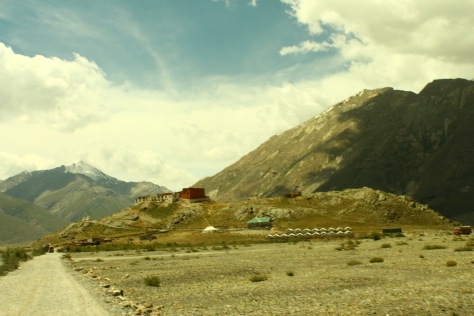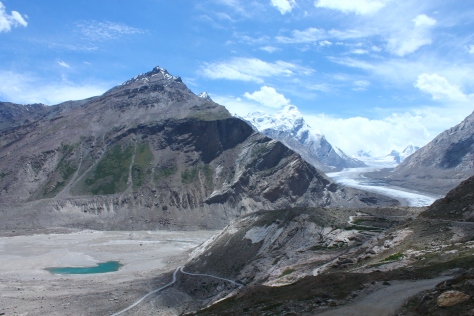It was a bright Ladakhi afternoon and she was boiling Maggi when I first entered ‘Rangdum Hotel’, called ‘hotel’, even though it hardly seemed to have any guest rooms. It was lunch time, but one probably didn’t need a taste of the noodles to say that they were disappointing, a look at the pan was enough. They were soggy and unappetising, somehow devoid of all the life that a sunny summer day in Ladakh embodies. When she spoke, there was a palpable sadness in her voice:
“Why does everyone eat at the café in front? Is his food that good?”, she asked in Hindi.
Couldn’t have been closer to the truth, I thought. Her Maggi just didn’t seem appealing. The man on the other side of the road, in contrast, served a neat Rajma chawal (and Maggi too on demand). I just tried ducking the question by focusing on her kids instead. Literally. The twin boys were excellent subjects for photography.

After half a dozen pictures, I could have taken another dozen of the two of them, together and singly, had the taxi not honked an equal number of times to call me. Rangdum, you see, is only half way through an almost heavenly but treacherous and 14 hour long ride from Kargil to Padum, the administrative center of the valley of Zanskar, that’s open to the outside world for only a few months in a year. Your heart could fall in love with the beauty of the landscape as many times as it could skip a beat staring at the gushing Suru river steeply beneath the road. As I rushed to the taxi, covering the camera lens, she beckoned,
“Will you simply take the photos or ever send them back to us at all?”
Quick to pick up a defensive note, I replied, “This place is so far off. How can I even send the photos back here?” and hastened my approach to the taxi. I got in, opened the windows to let in some fresh mountain air that was accompanied by her calls,
“Posts do arrive here. We have a postal address as well.”
I was just glad the taxi had taken off.
We moved on, crossing the 200 years old Rangdum monastery, through vast dried river beds, ambling our way past hordes of sheep every now and then. Crisp glacial air kept gushing into our little caravan of 9 men just like the words of the mother and my guilt associated with them. I had chosen probably the most inaccessible place in India for this one week, Padum. Even Leh was full of low-cost airlines, roaring Royal Enfields and a mish mash of mobile phone networks. Deep in the Zanskar valley, in Padum, you needed to line outside a phone booth to make calls to home. How on earth could I have taken the print of a digital photo?

The coming days I spent roaming around Padum. (Padum’s market itself though, could be wrapped up in a couple of hours, including spending 5 mins at every possible shop you can find) To my astonishment, I did manage to find a photo studio which helped me with the prints. I took not one, not two but four. In one, a kid darted stones around the huge expanse of ladakhi grounds, in the other, the second kid bent over to show his face upside down, and in the last two photos, they both stood staring there, in blue sweaters, their noses running most endearingly all the way to their lips and further.
In one instant I knew these fresh faces were the highlight of my trip, more than the two thousand years old Buddha carvings in Padum, or the millennia old Drang Drung glacier we encountered on our way there. I couldn’t have imagined their mother’s delight at seeing the photos.

Drang-Drung Glacier, the largest glacier for public view in Ladakh, a magnificent sight
A week later, when the day to leave Padum came, I couldn’t hide my excitement. As always, a taxi was ‘made’ with 9 passengers – 5 of whom were those who had come with us a week back. To my chagrin, it wouldn’t just move, because the 9th passenger failed to arrive in time from a nearby village. It was almost an hour before we finally set moving. And surprise, surprise, the other fellow passengers, all Ladakhis, didn’t even utter a word of displeasure to him! I, however, had little intentions of making any secret of my unhappiness that beautiful Zanskari morning. It turned out a little strange though. Just my first sentence had all of a sudden silenced not just the late-coming passenger but every other local as well. It wasn’t intended.
We passed again through the same mountains, but a previously barren landscape had changed within a week of our stay in Padum. It had rained and snowed, the mountains revealed a much different façade of varied shades of brown as white and grey clouds engulfed their peaks. Himalayan marmots sat kissing each other on wet rocks, school kids late for their classes, lined the single lane road, and waived their hands, in a bid to hitchhike in the first taxi that way. Reminded of my own school days spent waiting for (read missing) buses, I ensured the driver picked up each of them, only that their schools were literally villages away! They’d get down with several ‘Ju-Ju‘s (thanks) to the driver. The passengers would reply back with another set of Ju-Ju‘s. You can get half your work done in Ladakh with just Ju-Jus and Julays.

At Rangdum again, the taxi stopped for lunch. This time the weather was colder, damper and the skies greyer. Puddles of water surrounded by fresh green shoots of grass marked the distance between the two ‘hotels’ on either side of the road. I jumped out of the Qualis and ran all the way to the woman at Rangdum Hotel and handed over the envelope. I was imagining her jumping in the air out of pure delight. ‘How often would visitors do this for her’, I thought. She looked at the pics, glanced at all of them, placed them on a display on the shelf, said an inexpressive thanks to me and went back to her work. The noodles simmered under the cold, damp air. My emotions boiled within a confused me in the lack of her emotions. “What, the pics aren’t good?”, I couldn’t help asking. To my horror, she said they were just okay!
“Isme toh dono bachcho ki naak beh rahi hai, isme kaise achhe langenge‘!, she replied.

(“They both have running noses in these pictures. How are they supposed to look good?“)
It took me a while but then slowly it all came back to me. Those weeks spent in Ladakh five years back, that plain lack of emotions of the locals when we most expected them, that slight sadness for everything great in life, that still undying spirit of serving their guests.
For a Ladakhi, life didn’t come that easy. Beneath those local faces that seem so cute to a traveller, lie the cheeks burnt by a harsh combination of severe Sun and extreme cold. Beneath all those cozy hut-like guesthouses, lies a harsh terrain that’s disconnected from the whole world for 8 months in a year. In all those days I spent in Ladakh, I didn’t see a single Ladakhi angry. I didn’t see any Ladakhi jumping with joy either. Very few actually go all the way to express their emotions. Ladakh represents life in its barest forms, the most beautiful and the toughest at the same time. It takes time and patience for a city dweller to understand this fully, or even partially. After all, how many of us walked miles, to another village, to spend a day attending classes at school?
I could just smile at the motherly tone of her reply as I sat there letting all of these thoughts sink in.
I went back, in, to where she was making the same brothy maggi. I picked up a bowl from the table, and extended to her.
“Would you serve me a bit of that?”, I asked.









